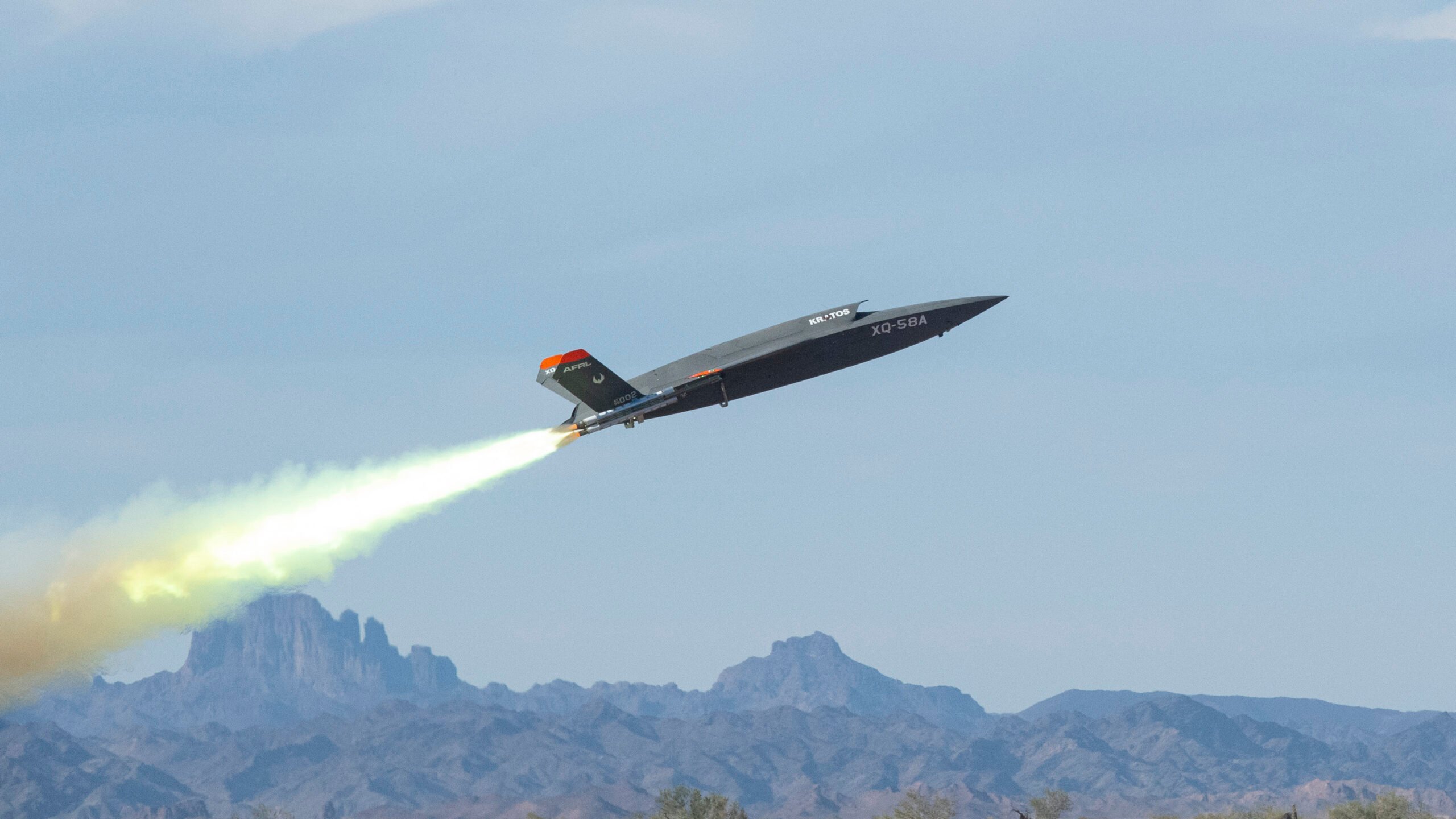
An XQ-58A Valkyrie launches at the U.S. Army Yuma Proving Ground, Ariz., Dec. 9, 2020. (U.S. Air Force photo by Staff Sgt. Joshua King)
WASHINGTON — Since the US Navy announced a $15 million contract for its own Valkyrie drones, the Defense Department has clarified that it’s actually the Marines who plan to experiment with the large unmanned aerial vehicles — giving the amphibious force options for new strike, intelligence gathering and electronic warfare capabilities as well as a “mothership” for small drones.
Steve Fendley, president of Kratos’ unmanned systems division, told Breaking Defense last week that his company has developed Valkyrie and other platforms to “offer a pretty dynamic capability set in the tactical arena at almost unheard-of affordability or price level… I think that’s what really has interested the Air Force for years, and now the Navy [and] Marines.”
RELATED: Following increased Air Force interest, Navy buys its own Valkyrie drones
The Pentagon earlier this month announced the Navy ostensibly had inked a $15 million contract with Kratos for two XQ-58A Valkyries, relatively large, unmanned drones weighing in at around 6,000 pounds with a roughly 27-foot-wingspan. (Those numbers put it in the Pentagon’s “group 5” category of unmanned aircraft, signifying it is among the largest the DoD uses.) However, a Defense Department spokesman following the contract’s award told Breaking Defense the deal is in fact on behalf of the Marine Corps.
“This contract was awarded by Naval Air Warfare Center Aircraft Division on behalf of the Marine Corps as part of a collaborative effort between the Marine Corps and the Office of the Undersecretary of Defense for Research and Engineering,” Lt. Cmdr. Tim Gorman told Breaking Defense. “It is part of ongoing USMC efforts to look at future autonomous platforms and is not connected to any other Air Force or Navy programs. These unmanned aerial systems are intended for experimental purposes.”
The Air Force in November began flying its Valkyries out of the 40th Flight Test Squadron at Eglin Air Force Base in Florida, Breaking Defense reported at the time. The Pentagon and Naval Air Systems Command declined to say more about what kind of experiments the Marines might be running, but one think tank’s public report might hold some clues as to how the Valkyries could be used.
In April 2022, the Hudson Institute published its own analysis on possibilities for future naval aviation capabilities. In that report, the authors suggested the Marine Corps deploy the Valkyrie from amphibious ships and bases ashore.
“The Navy and Marine Corps can exploit the 1,500-3,000 [nautical miles] range of these UAVs to support [electronic warfare] or [intelligence, surveillance and reconnaissance] missions,” according to the report.
The group 5 aircraft was first conceived in 2016 using a “clean sheet design” — meaning it was not derived or based off a previously existing drone — and made its first flight in 2019, according to Fendley.
Fendley said its capabilities follow that of most, larger unmanned aerial systems, including intelligence, surveillance and reconnaissance, and it can deploy certain munitions, such as the Small Diameter Bomb. Additionally, it is capable of acting as a “mothership” for smaller aerial drones and deploying those UAS mid-flight.
Kratos has also managed to turn Valkyrie into a communications relay, according to Fendley. The Kratos executive said the drone can be equipped with a special gateway payload that, when in range of both an F-35 Joint Strike Fighter and an F-22 Raptor, allows the two warplanes to communicate with each other, something not otherwise possible without an intermediary aircraft.
A demo, which took place around April 2021, was dubbed “Project Hydra” and featured the Valkyrie doing just that, The Drive reported at the time.
“Project Hydra marks the first time that bi-directional communications were established between 5th Generation aircraft in-flight while also sharing operational and sensor data down to ground operators for real-time capability,” said Jeff Babione, vice president and general manager of Lockheed Martin’s Skunk Works, said in a statement. (The Marine Corps flies a version of the F-35, but F-22s are predominantly flown by the Air Force.)
Kratos as a company is a mid-tier defense contractor, as Fendley describes it, with around 3,300 employees and is better known for the aerial target systems it provides to the Pentagon as well as foreign militaries. An aerial target system refers to an aircraft designed specifically to show up on a military’s radar presenting itself as a hostile adversary.
When asked about other variants of the XQ-58, Fendley said he could not get into specifics in terms of his company’s research and development efforts. But he did hint at the fact that the drone’s wide range of potential mission sets is partly why the Pentagon has taken interest in them.
The name “XQ-58 refers to the basic aircraft with the ability to fly by itself [and] to be able to communicate with other systems,” but not necessarily outfitted with a specific mission kit, such as the communication payload for F-35s and F-22s, he said. The ability to swap out various mission kits is “part of the interest from the Navy and Marines.”
Navy jet trainer fleet operations remain paused after engine mishap
One week after the incident, a Navy spokesperson says the service is continuing to assess the fleet’s ability to safely resume flight.


























